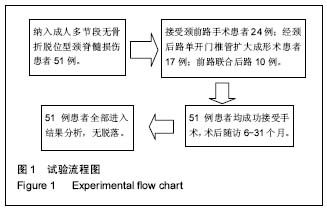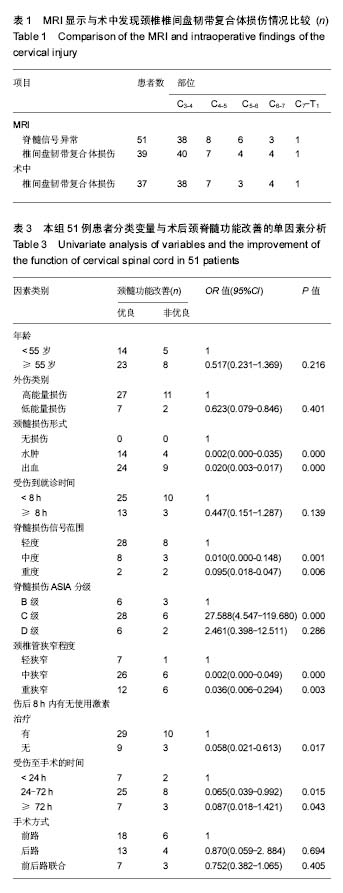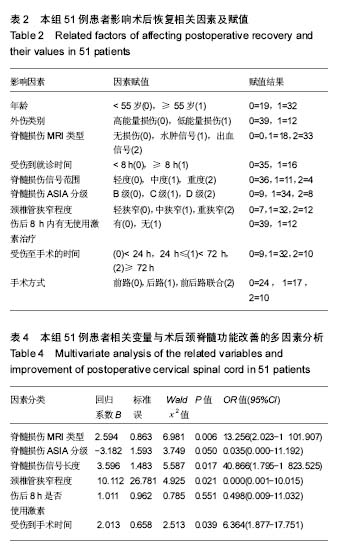中国组织工程研究 ›› 2017, Vol. 21 ›› Issue (31): 5036-5041.doi: 10.3969/j.issn.2095-4344.2017.31.020
• 骨与关节图像与影像 bone and joint imaging • 上一篇 下一篇
MRI在无骨折脱位型颈脊髓损伤诊断和预后分析中的作用
刘新阁1,李 涛2,陈方民3,韩敦富2,时 明2
- 1滨州医学院,山东省淄博市 255400;2淄博市中心医院骨科,山东省淄博市 256600;3滨州医学院烟台附属医院,山东省烟台市 264100
Effects of MRI in the diagnosis and prognosis of cervical spinal cord injury without fracture or dislocation
Liu Xin-ge1, Li Tao2, Chen Fang-min3, Han Dun-fu2, Shi Ming2
- 1Binzhou Medical University, Zibo 255400, Shandong Province, China; 2Department of Orthopedics, Zibo Central Hospital, Zibo 256600, Shandong Province, China; 3Yantai Affiliated Hospital of Binzhou Medical University, Yantai 264100, Shandong Province, China
摘要:
文章快速阅读:
.jpg)
文题释义:
无骨折脱位型颈脊髓损伤:是一种特殊的颈脊髓损伤,是指X射线、CT等影像学检查提示无骨折脱位,但患者在临床上有脊髓损伤表现,占所有颈脊髓损伤的3%-16%,其临床表现可轻可重,绝大多数为非完全性脊髓损伤,本组51例患者全部为不完全性脊髓损伤。
无骨折脱位型颈脊髓损伤的治疗:目前针对成人无骨折脱位型颈脊髓损伤选择手术与非手术治疗,仍然存在分歧。有学者认为,成人颈脊髓损伤多为不完全性,合理的保守治疗即可不同程度地恢复脊髓神经功能,且手术有可能使原有的脊髓损伤加重。但非手术治疗往往不能取得令人满意的疗效。
摘要
背景:中老年人的颈椎可因不同原因导致不同程度的椎管狭窄,在受伤时发生无骨折脱位颈髓损伤概率也相对较高,有文献报道可占颈段脊髓损伤的3%-16%。
目的:探讨MRI在诊断和预测无骨折脱位型颈脊髓损伤预后中的作用,并分析手术效果的影响因素。
方法:回顾分析2014年8月至2016年6月就诊于淄博市中心医院的51例成人无骨折脱位型颈脊髓损伤患者,根据影像学资料,分别采取前路、后路或前-后路联合手术,将术中所见颈椎骨韧带损伤与MRI表现对比。使用单因素和多因素Logistic回归分析患者的年龄、外伤类别、脊髓损伤MRI类型、受伤到就诊时间、脊髓损伤信号长度、脊髓损伤ASIA分级、颈椎管狭窄程度、伤后8 h内是否使用激素治疗、受伤至手术的时间、手术方式等10个因素对预后的影响。
结果与结论:①颈椎MRI较术中所见更全面显示了脊髓及椎间盘韧带复合体损伤(χ2=5.966,P < 0.05),且颈脊髓损伤与相应椎间隙平面椎间盘韧带复合体损伤有关(χ2=1.53,P < 0.05);②单因素分析结果表明,脊髓损伤MRI类型、脊髓损伤信号长度、脊髓损伤ASIA分级、颈椎管狭窄程度、伤后8 h内是否使用激素治疗、受伤至手术时间与脊髓神经功能恢复相关(P < 0.1);③再经多因素Logistic回归分析,脊髓损伤MRI类型、脊髓损伤信号长度、颈椎管狭窄程度、受伤至手术时间与脊髓神经功能恢复有明显相关性(P < 0.05);④结果提示,颈椎MRI因其组织分辨优势,在诊断无骨折脱位型颈脊髓损伤及预测其预后中具有重要作用;脊髓损伤程度、颈椎管狭窄程度及手术时机是影响术后疗效的主要因素。
中国组织工程研究杂志出版内容重点:人工关节;骨植入物;脊柱;骨折;内固定;数字化骨科;组织工程
ORCID: 0000-0003-1495-2187(刘新阁)
中图分类号:



.jpg)